I will be discussing my favorite and go-to analog synth emulations, which you can use for your productions and compositions.
What a time we are living in, right? We can access the warmth and texture of analog sound at literally one-tenth of the price of the original gear. Of course, the quality of these digital emulations is questionable, and there’s always the endless debate about whether digital emulations are good enough or not.
In my observation, though, I have found myself pretty satisfied with many of the digital emulation plugins I use. Sure, they may not give me the sound of the “exact” or “pure” original synth, but with enough tweaks and some additional work, I get close to the sound I want to achieve, which is more important than getting it to sound like the “original.”
That’s the flexibility you get with digital synth plugins. I thought it would be a good idea to share a list of the analog emulation synth VST plugins I love, some for their sound, some for how authentic they sound, some for their workflow, and for various other reasons. So, let’s get started.
1. Moog Minimoog
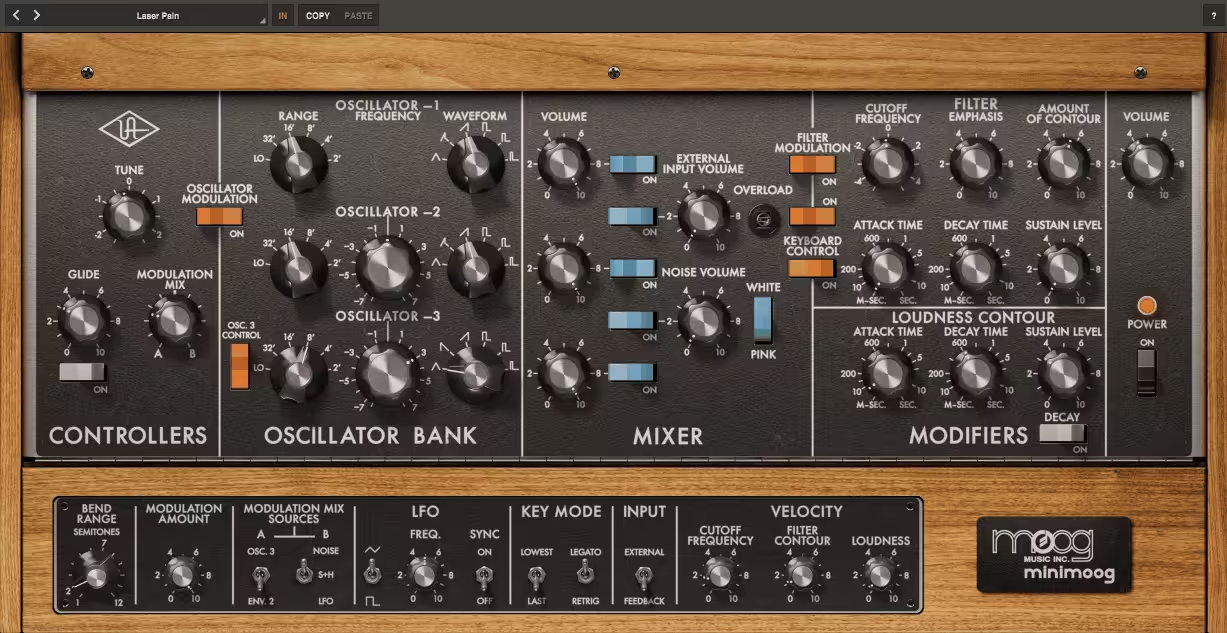
Let me just start by saying: the Minimoog is the analog synth VST that set the standard for what we think of as “synth sounds” today.
Whether you’re into vintage funk, classic rock, or modern beats, you’ve likely heard Minimoog‘s unmistakable fat, buttery tones. Now, thanks to modern plugin development, you can have this beast on your computer without dropping five figures or taking up precious studio space.
First off, I think the sound quality is unreal, as it nails the warm, growling tones of the original Model D hardware.
Universal Audio worked directly with Moog to model every last nuance, from the oscillators and filters to the subtle imperfections that give the original synth its character. They even used custom robotics to measure knob movements on vintage units. Yes, robots were involved.
- Digital Additions
What makes this plugin so great for me isn’t just its authenticity (although that’s reason enough to love it). It’s the combination of killer sound and modern conveniences. For example, you get custom mods that the original hardware didn’t offer, like an extra LFO, sample and hold, and adjustable note priority.
- Recall Sounds Anytime
Another perk of going digital? Total recall and endless instances. I love that I can forget worrying about patch memory or your synth going out of tune as with this new features I can load up 5 versions of this plugin in my DAW, automate every parameter, and save all my presets. Oh, and it doesn’t weigh 20 pounds.
- Easy Sound Design
Regarding sound, you get 3 oscillators, which are as fat and juicy as you’d hope, along with a noise oscillator, all of which you can tweak and adjust in its Mixer tab.
The workflow is just as good as any traditional synth plugin. Whether you’re stacking sawtooths for thick basslines or dialing in subtle pulse-width modulation for leads, it delivers.
With its ladder filter, you can crank the resonance without losing that punchy low end, something the real hardware also does beautifully. And yeah, they included the famous “feedback” trick, where you route the output back into the input for delicious overdrive.
Moog Minimoog is available in AAX, VST, and AU plugin formats and is compatible with macOS 10.15 Catalina or newer and Windows 10 operating systems.
2. Roland JUPITER-8
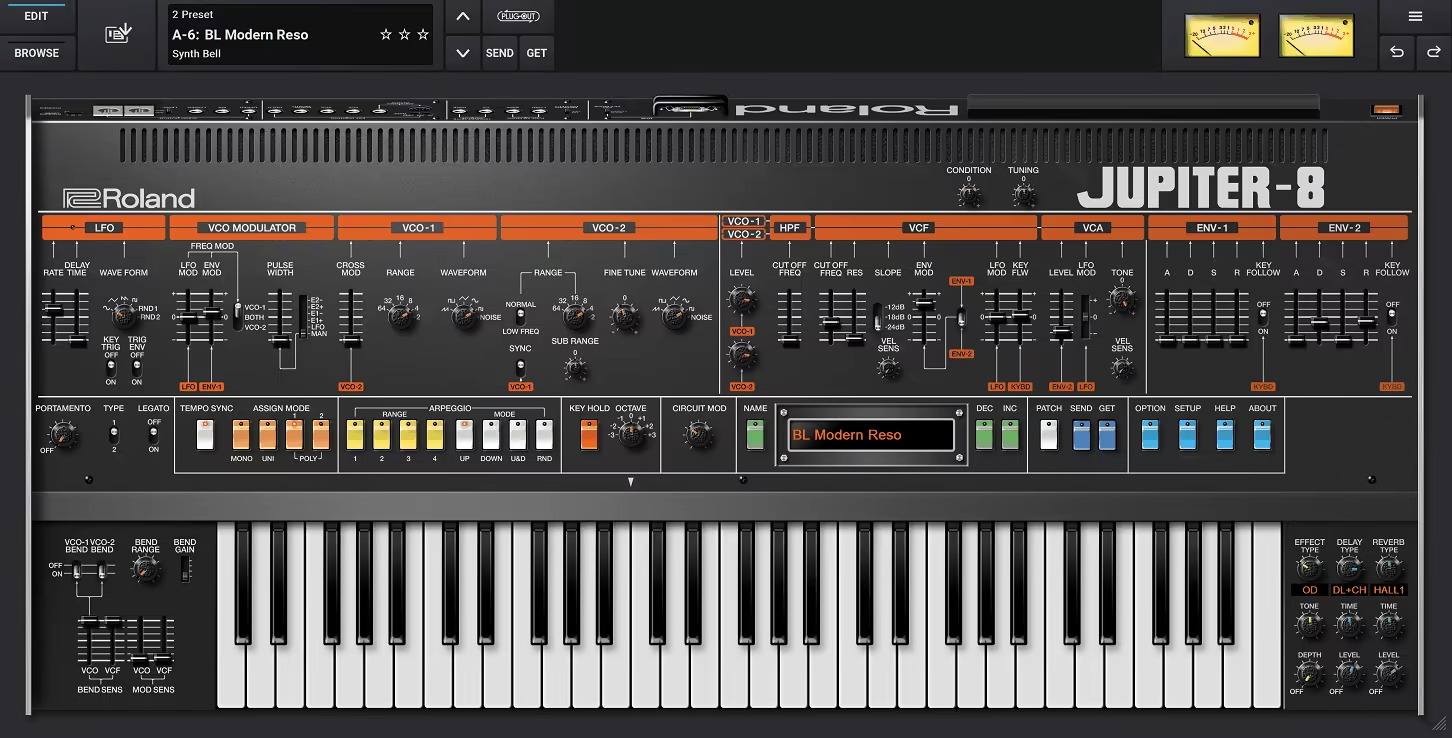
Let’s talk about the Roland JUPITER-8, a synth that basically wears a crown in the world of polysynths.
If the Minimoog is the king of mono, then the JUPITER-8 is the undisputed ruler of polyphony. Released in 1981, it quickly became the go-to weapon for everything from lush pads to infectious leads, and for good reason. This thing sounds massive, warm, and oh-so-dreamy.
I think the trick here is the its digital renaissance, that uses enhanced ACB (Analog Circuit Behavior) technology to replicate the circuits of the original synth. Plus, the high-definition, resizable interface really gives you that tactile, vintage feel while you’re tweaking away in your DAW.
- The Oscillators
You’ve got dual oscillators with a ton of waveforms to choose from, everything from classic saws and squares to sine and even noise. I am also a fan of cross-modulation and syncing between the two oscillators, which allows me to add more movement and complexity to my sounds and create everything from punchy bass to evolving textures.
- Built-in Effects
Coming to my favorite part: This is where the modern conveniences shine. You get access to chorus, reverb, flanger, delay, and many other effects. I’m a sucker for lush pads and soaring leads, and the JUPITER-8 delivers those in spades.
- Arpeggiator and Browser
The advanced arpeggiator is ridiculously fun to play with, offering modes like up, down, up & down, and random.
And let’s not forget the patch browser. Whether I’m layering dreamy chords or crafting infectious arpeggios, this synth has a certain “it” factor that’s hard to describe but impossible to ignore.
And while the original hardware had a strict 8-voice polyphony limit, this analog VST synth plugin lets you adjust it from 2 to 8 notes depending on your needs (and your CPU’s patience).
What seals the deal for me is the Circuit Mod feature. It lets you tweak the internal behavior of the synth in real time, which is perfect for dialing in just the right vibe, whether that’s silky-smooth or slightly gritty. And the extended parameters are also quite helpful.
Roland JUPITER-8 is available in AAX, VST2/3, and AU plugin formats and is compatible with macOS 11 or newer and Windows 10 or later operating systems.
3. GForce Software Oberheim OB-1
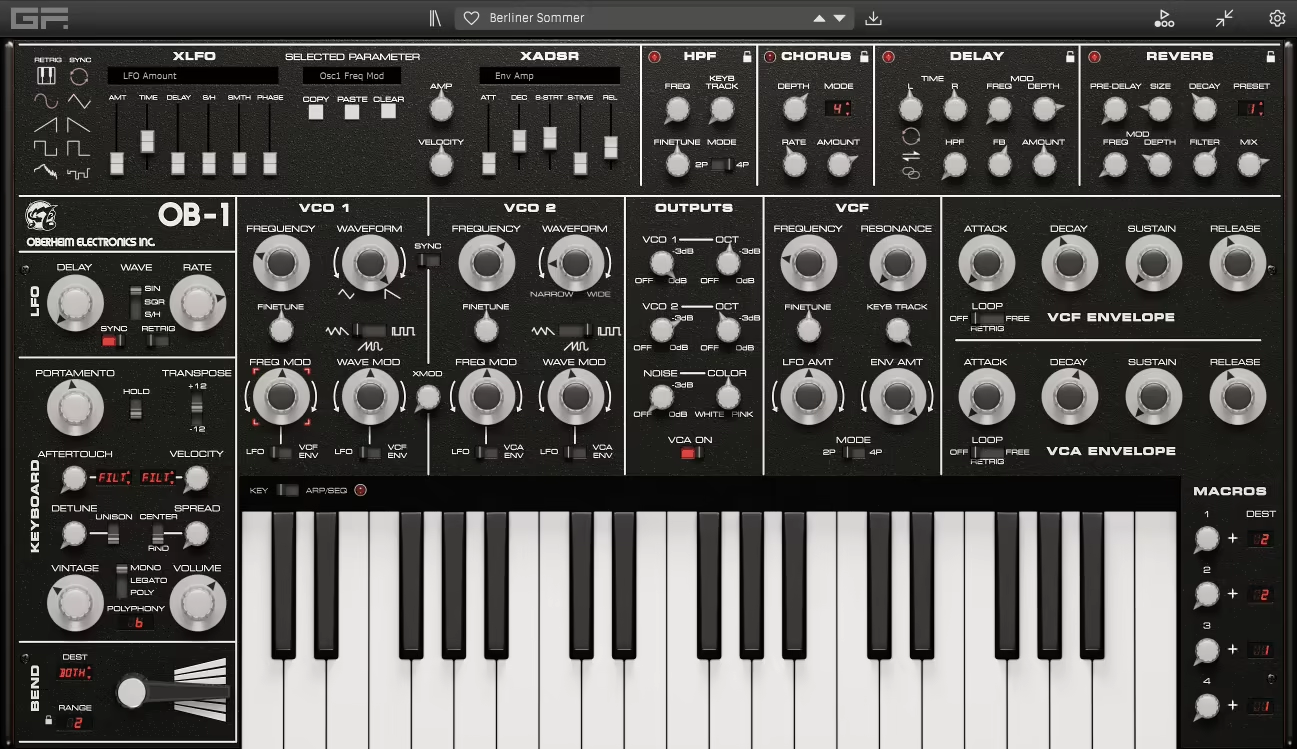
The GForce Software Oberheim OB-1 is a fascinating take on the classic vintage synth.
The OB-1 retains the charm of the original Oberheim OB-1 but adds a wealth of options that make it much more than a simple clone. Imagine a vintage synth modified to its limits, loaded with extra features and creative possibilities.
- Modulation Capabilities
For me, the interface is well-organized yet packed with tools that vastly expand the capabilities of the original OB-1. Among the most significant additions are the XLFO (extra LFO) and XADSR (extra ADSR) envelopes. While they may initially seem like simple extras, I believe these tools unlock a world of modulation possibilities for most producers.
Almost every parameter in the OB-1 can be modulated with its own dedicated LFO and envelope, which means you’re not constrained by a limited number of modulation sources and can assign unique modulation to nearly every knob, creating an immensely complex and dynamic sound design environment.
For instance, you can independently modulate each oscillator’s pulse width modulation (PWM) using their own XLFOs, freeing up the synth’s core LFO for other tasks. Additionally, you can stack modulation sources for even more depth.
- Filter Section and Effects
The OB-1’s filter is another highlight, as it offers both two-pole and four-pole modes, with the ability to self-oscillate in both configurations. The filter’s resonance is smooth and capable of producing some truly unique tones, especially when combined with key tracking.
On the effects side, the OB-1 includes a rich reverb, versatile delay, and lush chorus.
I found the reverb is particularly impressive, with an enormous decay that creates a massive sense of space. The chorus delivers a Juno-esque vibe, making it perfect for classic synth pads and leads.
But, what I find really flexible is that all effects are fully modulatable using the XLFO and XADSR envelopes, a feature missing in many analog synth emulations. Pretty great analog synth emulation VST overall!
GForce Software Oberheim OB-1 is available in AAX, VST2/3, and AU plugin formats and is compatible with macOS 13 or newer and Windows 7 or later operating systems.
4. Knif Audio Knifonium
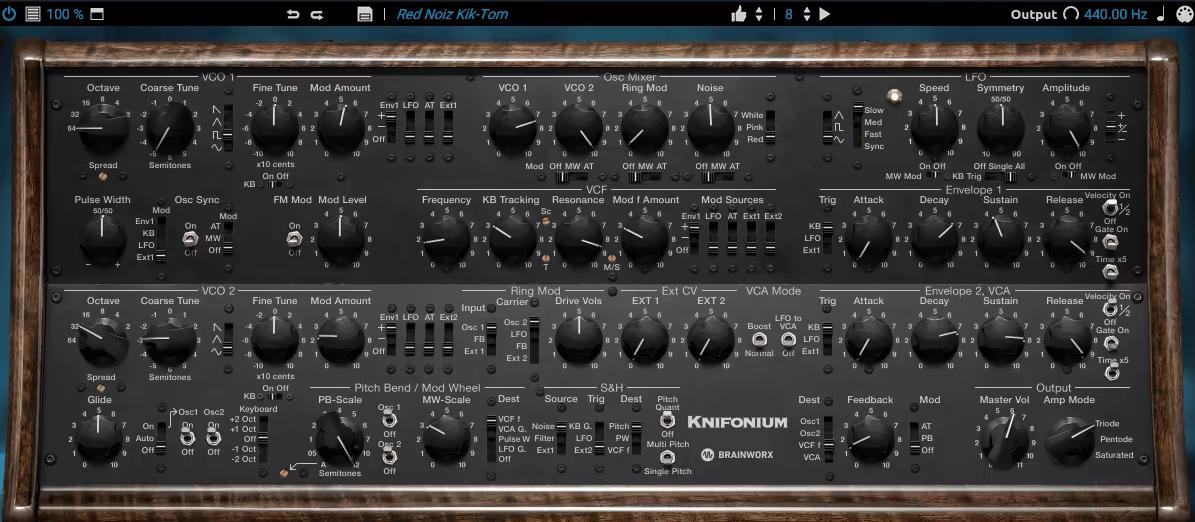
The Knif Audio Knifonium is modeled after a hardware unit powered by 26 vacuum tubes.
Known for its striking “steampunk” aesthetic and unparalleled sound design capabilities, this boutique synth comes with two tube-driven oscillators, a fourth-order ladder filter, and a ring modulator and delivers the warmth and richness that only true analog synthesis can provide.
- Enhanced for Modern Creativity
The Knifonium introduces polyphony with up to 8 voices, enabling lush pads and expansive soundscapes powered by the equivalent of 208 modeled vacuum tubes.
It also features Brainworx’s patented Tolerance Modeling Technology (TMT), recreating the natural inconsistencies of analog circuits for an authentic sound. I liked that they also have additional enhancements like stereo spreading, unison mode, and a robust suite of effects such as a vintage-style phaser, EQ Ranger, and Waveshaper.
- Incredible Effects Section
When I treid the unit I found out that the built-in effects feel like they were designed to complement the synth perfectly.
The Waveshaper is great for adding grit, while the phaser and reverb add a lush, vintage vibe. My favorite is the stereo spread and mid/side processing, which make it effortless to create mixes that sound professional and spacious.
- Intuitive Arpeggiator
The arpeggiator isn’t just functional; it’s creative and its stereo panning options allow me to create moving, dynamic patterns that flow from left to right, instantly adding life and motion to sequences.
- Brainworx TMT Technology
This feature replicates the natural variations of real analog circuits, giving each note a slightly different character. I thinkt it’s pretty subtle, but it makes everything feel more alive like I’m working with a physical piece of gear.
Knif Audio Knifonium is compatible with DAWs that support AU, VST, VST3, and AAX plugin formats and works with macOS 15 down to macOS 12 and Windows 10 or above operating systems.
5. Arturia Mini V
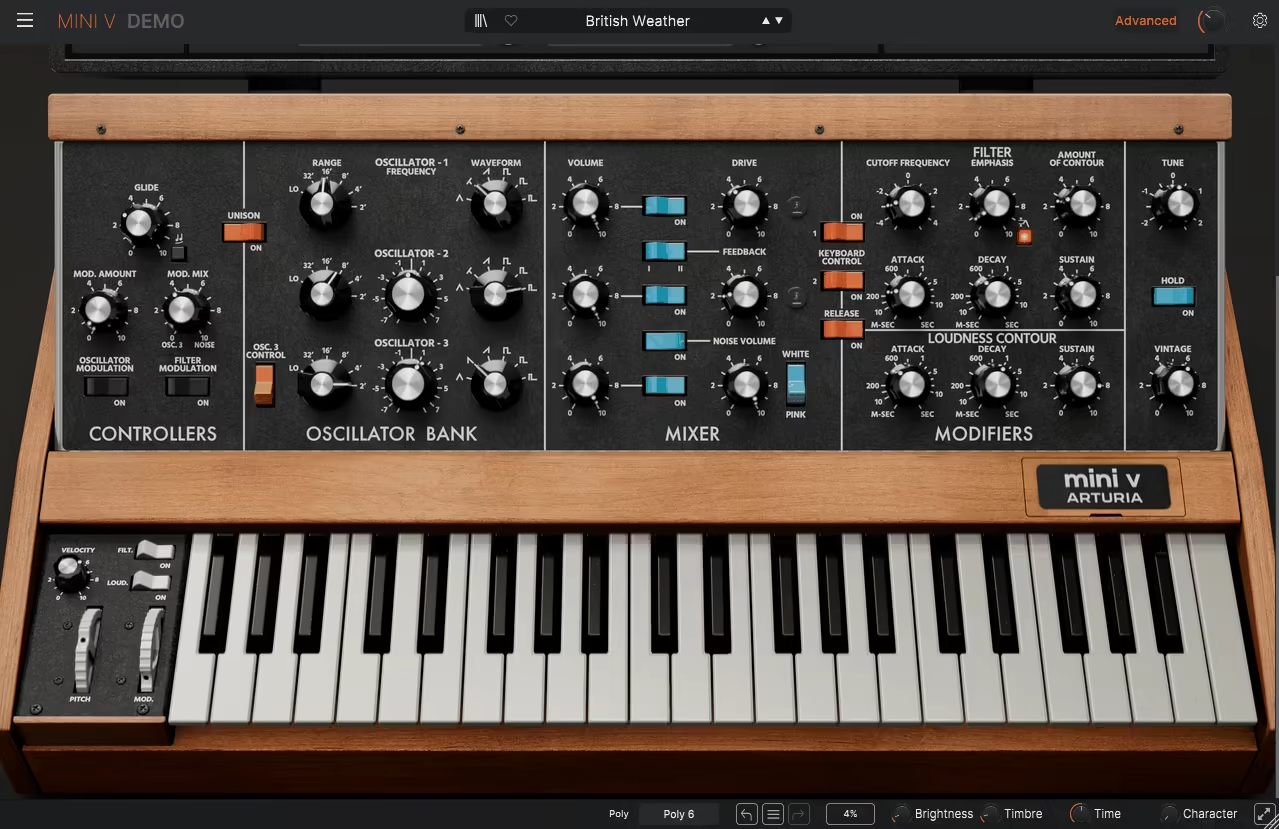
The Arturia Mini V is Arturia’s recreation of the MiniMoog synthesizer.
Its core sound engine meticulously emulates the warmth and richness of the original MiniMoog, down to its three analog oscillators, Moog ladder filter, and signature monophonic architecture.
However, Arturia has enhanced the design with features like filter loss compensation and advanced modulation options, which I found pretty great.
- Three Redesigned Oscillators
In my opinion, these oscillators offer exceptional sound quality and flexibility, with waveform options ranging from triangles to multiple pulse shapes. Oscillator 3 can also double as an LFO, adding a layer of modulation possibilities.
- Enhanced Ladder Filter
The classic Moog filter is as smooth and musical as ever but now includes bass compensation, ensuring the low-end remains punchy even with high resonance settings, giving you solid analog thickness. I love the basslines created with it, thanks to the Enhanced Ladder Filter.
- Advanced Modulation Options
With added modulators, LFOs, and a function generator, I was able to craft evolving textures or rhythmic modulations that bring your sounds to life. You also get a suite of onboard effects, including drive, feedback, reverb, and chorus, allowing you to add more character and depth without needing external plugins.
- Unison Mode and Vintage Knob
I love how the plugin’s Unison mode creates massive, detuned monophonic sounds while the Vintage knob introduces subtle analog imperfections, mimicking the quirks of a well-loved MiniMoog.
Arturia Mini V is compatible with DAWs that support AU, VST, VST3, and AAX plugin formats and works with macOS 11 or later and Windows 10 or above operating systems.
6. discoDSP OB-Xd
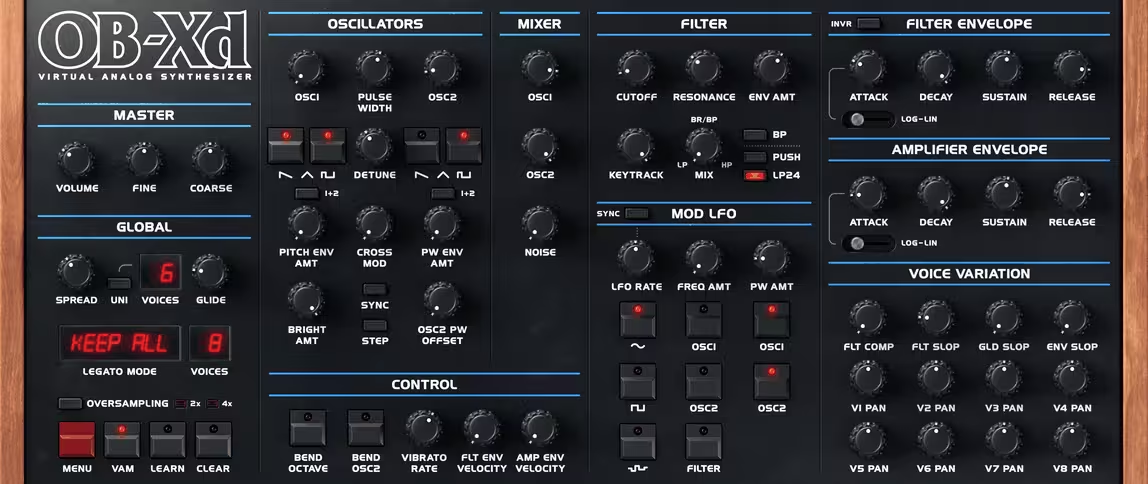
OB-XD 3 introduces a modernized interface, vastly improved from the older, clunky UI.
However, resizing options remain unavailable, which might disappoint some users. Despite this, the synth’s visual overhaul makes it more user-friendly overall.
- Expanded sound design tools
I would start by talking about its Unison mode, which allows for adjustable voice counts and enables richer and more dynamic tones. Additionally, the new oversampling options (2x or 4x) improve the overall audio quality, reducing aliasing and enhancing clarity.
Another welcome addition is the self-oscillating filters, activated with a dedicated push button, adding more depth and complexity to your patches.
- Filters and Modulations Enhancement
The oscillator and modulation improvements are also significant. You get fine control over pulse width and modulation, with added cross-modulation and oscillator sync options. The LFO section has been refined with enhanced modulation depth and the ability to target specific oscillators or filter parameters, making it easier to create evolving, expressive sounds.
OB-Xd 3 also introduces upgrades to the filter section, allowing seamless morphing between low-pass, band-pass, high-pass, and notch filters.
I enjoyed using the adjustable filter envelope attack curves and inversion settings, as they provide greater sonic flexibility, making it easier to sculpt unique timbres.
The most exciting feature for me is its analog behavior simulation, which brings the imperfections and organic movement of real analog synths into the digital realm. The new “Voice Variation” options replicate the natural inconsistencies found in vintage hardware, affecting filters, glide, envelopes, and panning to create a more authentic and dynamic sound.
discoDSP OB-Xd is available in AAX, VST, and AU plugin formats and is compatible with Windows 10+, Mac OS 10.14+ (Apple Silicon or Intel), and Ubuntu 20+ (Intel Core i3+) operating systems.
7. Roland SYSTEM-8
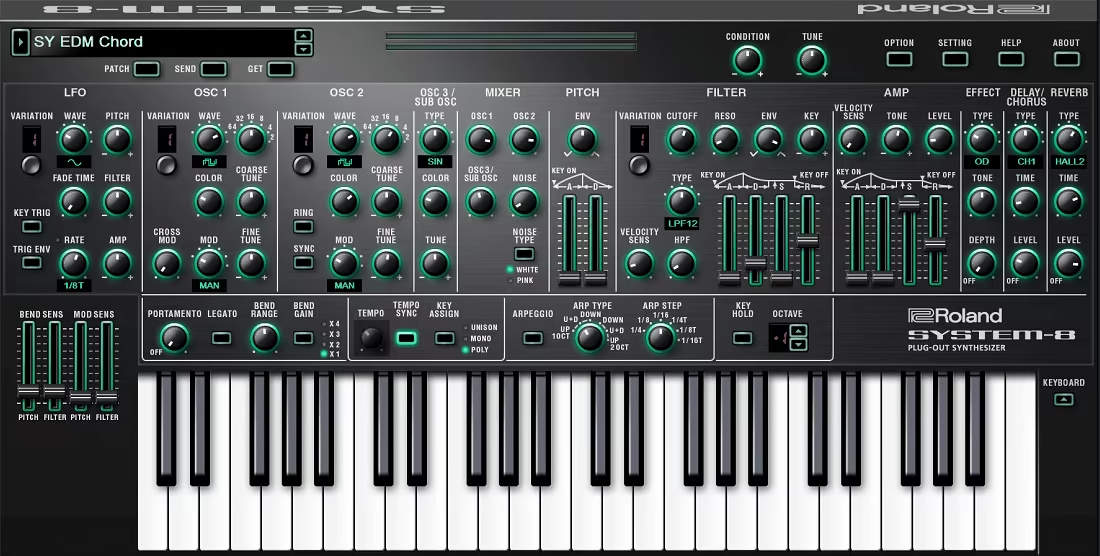
Roland SYSTEM-8 is an analog VST plugin synthesizer that brings together classic Roland sound and modern digital synthesis in one flexible plugin.
Drawing from Roland’s rich history of synth design, the SYSTEM-8 faithfully emulates classic Roland oscillators, filters, and effects while introducing new sound-shaping capabilities that push beyond vintage limitations.
- Advanced Sound Sources
At its core, the SYSTEM-8 features 3 oscillators per voice, each offering an extensive selection of waveforms. I liked that they have traditional analog-style waves like saw, square, and triangle alongside more modern options such as FM, SuperSaw, and even vowel synthesis.
- Warm Filters
The filter section is also equally impressive for me, with multiple models that include classic Roland designs, such as the revered JUPITER and JUNO filters, alongside more experimental options like harmonic, formant, and side-band filters.
- Modulations and Effects
One of the standout features of the SYSTEM-8 is its deep modulation system, such that each oscillator, filter, and amplifier stage comes with detailed modulation controls, including dedicated LFOs, envelope triggering, and extensive cross-modulation options.
The onboard effects in SYSTEM-8 include overdrive, phaser, distortion, and bit-crushing options for adding character, while spacious reverbs, flangers, and delays allow you to craft lush, atmospheric textures directly within the plugin.
The effects might be standard but the I think the selling point here is the deep modulation system for those looking to get experimental with their sound.
Roland SYSTEM-8 is available in VST, AU, and AAX plugin formats and is compatible with macOS 10.14 or newer and Windows 10 or later operating systems.
8. GForce Software Oberheim SEM
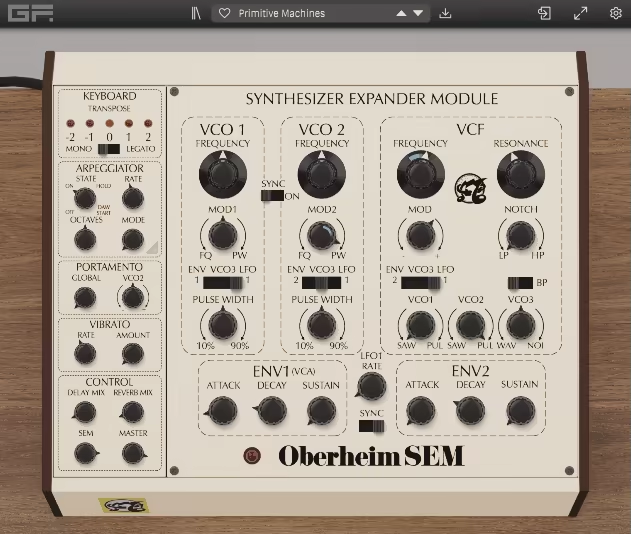
Originally designed by Tom Oberheim in 1974, this little beast was all about simplicity with a huge sound.
Oberheim SEM, as we know, was monophonic, straightforward, and insanely musical and used by legends like Stevie Wonder, Herbie Hancock, and Prince. When I found out that GForce Software had teamed up with Oberheim himself to create a software version, I knew I had to try it.
- Preserves Original Tone
From the moment I loaded up the Oberheim SEM, I could hear the raw, organic character that made the original hardware famous. It’s built around two VCOs (with Pulse and Sawtooth waveforms) and that legendary multi-mode filter, one of the most unique and expressive filters in synth history.
- Warm Sound
Unlike the standard 4-pole filters found in Moogs and ARPs of the era, the SEM’s filter gives you low-pass, high-pass, band-pass, and notch modes that you can seamlessly blend together.
- Straightforward Workflow
What I love most about the GForce SEM is its pure, no-nonsense approach. It doesn’t overwhelm you with a million mod matrix options or endless menus. You just dive in and start tweaking and it always sounds good.
Need a thick bass? Dial in a saw wave, close that filter down, and boom. Want a soaring, expressive lead? Open up the resonance and let it sing. The envelopes are snappy and musical, the oscillators have a beautifully raw edge, and the filter has a smooth-yet-biting character that gives everything a vintage touch.
- Upgrade over original
Now, GForce did add a few modern touches, and I’m not mad about it. Unlike the original, which had only two oscillators, this version includes a third oscillator that can double as an LFO, adding some extra modulation options.
There’s also a built-in arpeggiator and step sequencer, which is a dream for quickly sketching out ideas. These additions are super intuitive and don’t take away from the SEM’s minimalistic charm, they just make it even more fun to use.
One thing that really stands out is how authentic this thing feels. GForce didn’t just slap an “Oberheim” logo on a generic soft synth. Every part of the SEM, right down to its subtle analog imperfections, has been painstakingly modeled.
GForce Software Oberheim SEM is available in AAX, VST 2/3, AU, and Standalone plugin formats, and it works with MacOS 10.13 or above and Windows 7 and above operating systems.
9. Softube Model 80 Five Voice Synthesizer
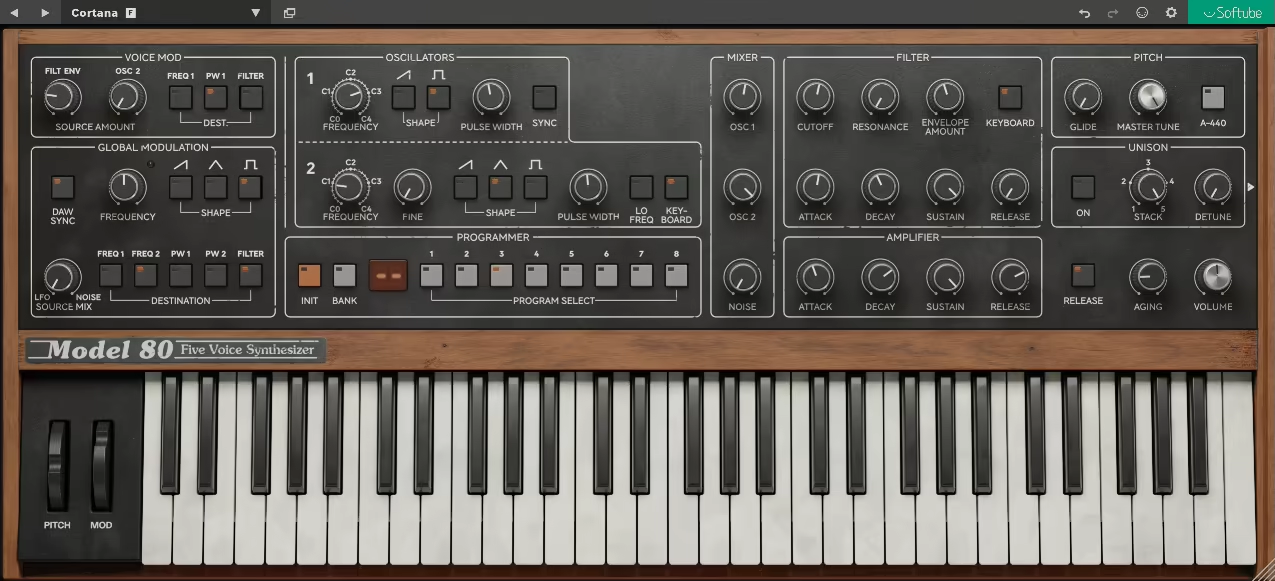
The 5-voice Model 80 was the first synthesizer to combine a digital microprocessor with an analog polyphonic synth engine.
Model 80 Five Voice Synthesizer gives you the unmistakable warmth and depth that made the original so iconic. This isn’t just another vintage emulation but a deeply detailed recreation that delivers the organic movement and analog imperfections that make classic synths desirable.
- Sound Design Wonder
At its core, the Model 80 is a 5-voice polyphonic analog synth, meaning you can play full, lush chords that retain the richness of analog hardware.
Softube has nailed the way the oscillators interact, from subtle pitch drift to the way harmonics stack when detuned. I liked VCO section, which offers classic triangle, saw, and pulse waves with pulse width modulation that can add depth and movement.
One of my favorite things about this synth is the filter section, a beautifully modeled low-pass resonant filter that can go from smooth and creamy to aggressive and biting with a small tweak.
- Modulations
Softube has designed Model 80 to work seamlessly within their Modular system, giving you a fully modular experience with five individual modules: VCO, VCF, envelope, LFO, and multi-pan.
In my experience it allows the user to get advrtange of the features in creative ways, apply complex modulation, and build patches that extend far beyond what the original hardware could do.
Even outside of Modular, I think the synth itself has fantastic performance controls. You can fine-tune each voice separately, apply LFO modulation to pulse width and filters, and even spread voices across the stereo field using the multi-pan module.
Softube Model 80 Five Voice Synthesizer is compatible with Monterey 12, Ventura 13, Sonoma 14, Windows 10 (64-bit), and Windows 11 operating systems and is available in AAX, VST, and AU plugin formats.
10. Eplex7 DSP Klerhaim N1
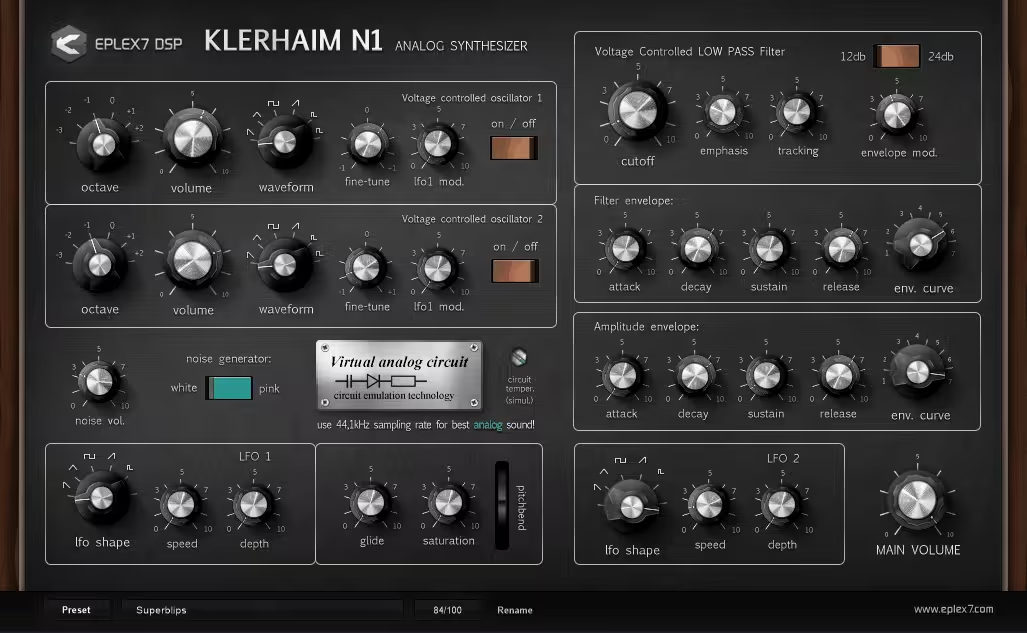
Eplex7 DSP Klerhaim N1 is a monophonic analog-modeled synth that is all about the imperfections, quirks, and movement that make real analog hardware so special.
Well, I will start with the two oscillators with a variety of classic waveforms like saw, square, triangle, and pulse, plus some built-in noise and harmonic enhancement that add extra depth.
The pitch drifts subtly, the filter sweeps feel alive, and even the amplitude has slight fluctuations, just like on a vintage analog synth.
- Analog-Modeled Goodness
If you’ve ever spent time programming analog synths, you know that nothing is ever static; the oscillators have natural variations, the filter cutoff subtly shifts, and envelopes behave with tiny inconsistencies. Eplex7 nailed this behavior, making it feel like you’re playing an actual piece of hardware rather than a virtual instrument, which I think is a great achievement.
The filter section offers 12dB and 24dB modes, and its resonance is thick and organic, and sweeping the cutoff feels smooth and musical. And the saturation control? Absolute gold. When I turned it up, suddenly it gave me thick, overdriven harmonics that made basslines punch and leads scream.
- Temperature, Drift, and That “Analog Feel”
One of my favorite features is the Temperature control, which essentially dials in the amount of analog unpredictability. Crank it up, and the synth starts to drift and behave unpredictably, just like an old piece of gear warming up in the studio.
- Monophonic Power Turns Poly?
Now, Klerhaim N1 is monophonic, which makes sense given its focus on old-school subtractive synthesis.
But here’s the cool part! If you use Reaper’s MIDI splitter or similar tools, you can actually turn it into a polyphonic synth by stacking multiple instances, giving you multiple voices of Klerhaim N1 stacked in lush chord sounds.
Eplex7 DSP Klerhaim N1 is available only in VST plugin format.
11. Tone2 Saurus 4
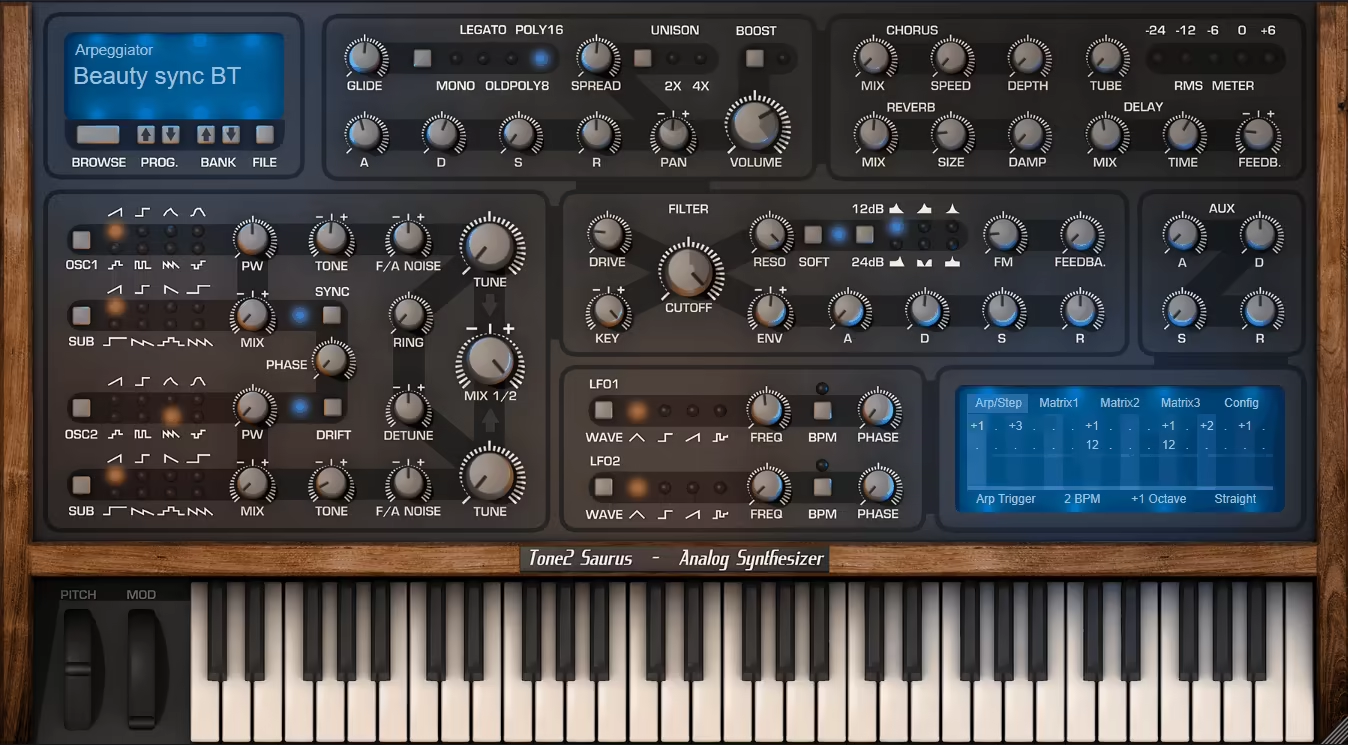
I love how organic, alive, and authentic Saurus 4 is.
Saurus 4’s oscillator section is where this synth truly shines. It includes pulse-width modulation (PWM), sync, ring modulation, frequency modulation (FM), amplitude modulation (AM), and noise, allowing for an incredibly broad spectrum of tones.
I found this one to be different than many synths where PWM is only available on square waves, cause Saurus lets you morph any waveform, giving you massive sound-shaping flexibility.
And let me talk about filtering because no true analog emulation is complete without a killer filter. The self-oscillating, non-linear analog-modeled filter in Saurus delivers everything from silky, lush sweeps to aggressive, overdriven growls.
It’s modeled after the most famous analog filter circuits, complete with FM, feedback, and analog-style saturation.
- High Modulation Potential
While Saurus 4 can perfectly emulate classic hardware like the Minimoog, Prophet-5, or Juno, it also goes beyond vintage with features that push it into modern sound design territory.
Ah, I should mention its arpeggiator, which is particularly impressive. It’s not just a simple note repeater and includes custom step patterns, swing, per-step velocity, and chord sequencing, making it a creative tool rather than just an afterthought.
And then there’s the modulation system, which is as deep as it is intuitive. Drag & drop routing lets you instantly assign modulation sources to nearly any parameter, and you can even push modulation into audio-rate speeds for aggressive FM textures and wild movement.
- Analog Sound, Digital Efficiency
In my experience, one of the biggest drawbacks of many high-end analog emulations is CPU consumption, but Saurus feels efficient. Despite its deep modeling, it runs buttery smooth, even on older systems, making it perfect for stacking multiple instances in a session.
And while many classic synths struggled with tuning issues, Saurus 4 offers microtuning options that allow for precise analog drift. It can even analyze melodies in real-time and subtly detune voices, making chords fatter, warmer, and more harmonically rich, without sounding artificial.
Tone2 Saurus 4 is available in VST and AU plugin formats and is compatible with Windows XP or later, Linux, and macOS 10.12 or newer operating systems.

Shaurya discovered his passion at the intersection of writing and music. Starting his career as a songwriter and rapper, he gradually picked up FL Studio and soon delved deep into the world of audio engineering and music production. Based in Delhi, India, he has worked with top studios, been featured on Red FM, garnered millions of streams on Spotify, and released music with major labels like Sony and Hitz.
